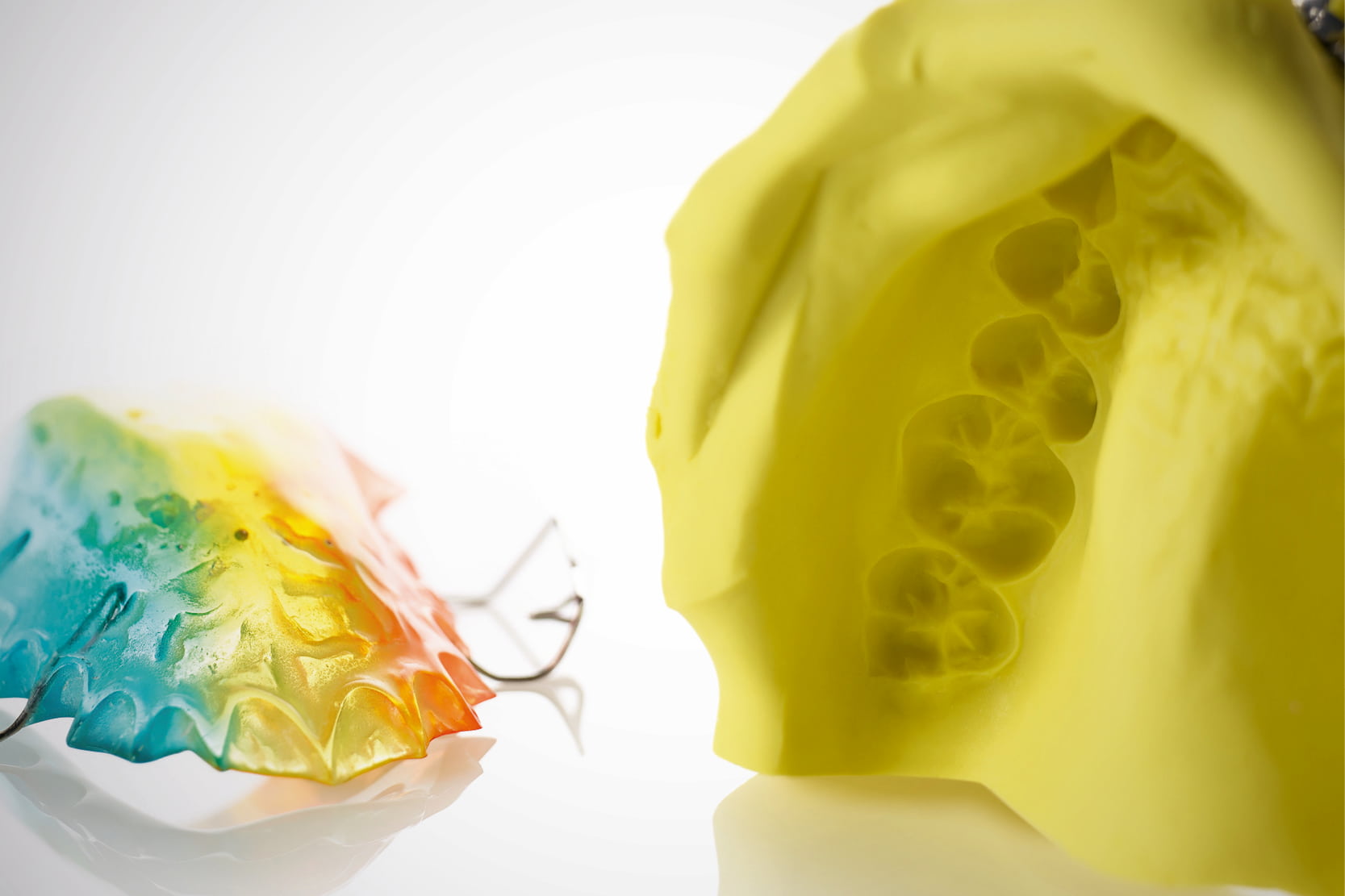
The field of orthodontics has seen a clinical and technical revolution in the last twenty years. Prior to the 2000s, multi-bracket treatments represented the only option for aligning, levelling or moving teeth. Today, on the other hand, orthodontists can count on innovative new treatments based on clear aligners.
As a discipline, modern orthodontics can be traced back to the early 1800s. Practitioners had to wait until the 1970s, however, to benefit from straight-wire appliances, thanks to the pre-adjusted brackets conceived and developed by Lawrence F. Andrews. (1)
As patients began to demand more attractive treatments, orthodontists gradually developed less aesthetically invasive alternatives, eventually leading to lingual braces, the first truly aesthetic orthodontic appliances. (2)
Clear aligners, the go-to clinical and product solution
Dentists had to wait until the late 1990s before the first clear aligners arrived. In 1997, two students from Stanford University developed the first complete system of clear aligners. Until then, a few rudimentary, pioneering attempts had been made to move teeth using clear, thermoformed masks, but had proved unsuccessful.
The system proposed by the two students was rapidly developed and soon became the go-to clinical and product solution in orthodontics. Ever since the early 2000s, there has been continuous development in clear alignment systems. Initially effective only in the simplest cases, they have since been adopted in increasingly complex cases and virtually replaced traditional appliances a few years ago.
The impressive growth in clear aligner sales illustrates the extent of this revolution. (3) This new treatment system has spread like wildfire around the world, attracting the attention of patients, dental practices and teaching universities, and finding ever greater interest among dentists.
But what real advantages do clear aligners offer compared to traditional appliances?
Advantages of clear aligners
Aesthetic – The main advantage of aligners is aesthetic. Leaving lingual braces aside for the moment, treatments with clear aligners are certainly less visible and anti-aesthetic than even the most attractive traditional ceramic braces. (4)
Reduced plaque build-up – The second advantage is reduced plaque build-up. A major comparative study has shown that clear aligners are better for periodontal tissue health than traditional appliances and are therefore recommended for patients at risk of gingivitis. (5)
Less risk of White Spot Lesions – Patients fitted with clear aligners are also at less risk of developing the white spot lesions (6) caused by demineralisation of the enamel around traditional braces as the result of increased plaque build-up.
Reduced number of visits required – Another significant advantage for the dental practice and the patient lies in the greatly reduced number of visits required over the course of the treatment. With aligners, there are no brackets to become detached, no wire arches to hurt the cheeks, and no bands to become unstuck. Visits for urgent repairs are therefore drastically reduced.
Far less troublesome to the patient – A systematic review of the literature has shown that in the first few days at least, aligner treatments are far less troublesome to the patient than conventional multi-bracket treatments. (7)
Another important aspect is that the dental practice only needs to work directly with the patient in certain phases of the therapy. This is not the case with fixed appliances. Provided treatments have been properly planned, appointments can become fewer as time passes, especially if patients are willing to cooperate.
Patient can eat and clean his teeth normally – The patient also derives a number of unquestionable advantages. He can eat what he wants and clean his teeth normally. He can remove the aligner, eat anything without fear of detaching a bracket, clean his teeth and, finally, replace the aligner.
Disadvantages of clear aligners
Effectiveness depends on patient collaboration – One major disadvantage of aligner treatments is that, because the appliance can be removed, effectiveness depends largely on patient collaboration. To be effective, aligners need to remain in place at least 22 hours a day. (8) Basically, though they are removable, aligners should be treated as fixed appliances. Lack of patient collaboration often causes dentists to opt for a conventional, fixed appliance instead.
It is also essential for the patient to clean his teeth after meals before replacing the aligner. If this is not done, food residues attach to the teeth for longer, since the cleansing action of saliva is eliminated, and this can increase the risk of caries.
Time for replacements – If aligners become lost or broken, patients have to wait some time for replacements to be produced and delivered. In the worst cases, they may have to have new impressions taken.
Higher costs – Generally speaking, aligner treatments also involve far higher laboratory costs, and this is reflected in higher prices to the patient.
To produce an aligner, you need an accurate impression with no recesses or distortion and with excellent dimensional stability, as the laboratories that make them are often far away from the dental practice. Only elastomers (addition silicones or, if necessary, polyether) should be used for this reason. A digital scanner can be used as an alternative.
Effectiveness and efficiency of clear aligners
This is the fundamental question. Clinically speaking, are invisible aligners and conventional braces equivalent? Do they produce the same results? And if so, are they equally simple to use and rapid?
Unfortunately, we cannot rely on an extensive body of literature to answer these questions: very few works are available for comparison. (9)
Nevertheless, according to this article (9), clear aligners are generally able to align and level arches, intrude anterior teeth in a reasonably predictable manner and control the vestibular-lingual inclination of posterior teeth. The extrusion of anterior teeth, rotation of rounded teeth, and the control of vestibular-lingual inclination in anterior teeth are more problematic.
According to a recent, extensive and much-quoted meta-analysis, (10) aligners are effective in aligning and levelling arches and in controlling anterior intrusion but not anterior extrusion; likewise, they are effective in controlling molar movements up to 1.5 mm, but not in controlling the rotation of teeth with rounded crowns. The results of these meta-analytic works nevertheless reflect the small number and low quality of the articles compared.
Another very recent article (11) concludes that clear aligners can be used in cases of mild and moderate crowding but that greater care is required in more complex scenarios.
Conclusions
To conclude, as with all orthodontic techniques, clear aligners have their advantages and their disadvantages. Their technical limitations therefore need to be understood and taken into consideration during the planning of treatment. Still today, traditional multi-bracket appliances remain the gold standard orthodontic treatment.
However, considering their undeniable benefits and their continuous technical development, it is only right to see clear aligners as effective, efficient, and suitable for a large number of clinical contexts. They therefore represent an increasingly valid alternative to traditional braces.
Bibliography
- Andrews, L. F. (1979). The straight-wire appliance. British journal of orthodontics, 6(3), 125-143.
- Echarri, P. (2006, September). Revisiting the history of lingual orthodontics: a basis for the future. In Seminars in Orthodontics (Vol. 12, No. 3, pp. 153-159). WB Saunders.
- https://www.grandviewresearch.com/industry-analysis/clear-aligners-market#:~:text=The%20global%20clear%20aligners%20market%20size%20was%20estimated%20at%20USD,USD%202.9%20billion%20in%202021.&text=The%20global%20clear%20aligners%20market%20is%20expected%20to%20grow%20at,USD%2015.9%20billion%20by%202028.
- Alansari, R. A., Faydhi, D. A., Ashour, B. S., Alsaggaf, D. H., Shuman, M. T., Ghoneim, S. H., … & Dause, R. R. (2019). Adult perceptions of different orthodontic appliances. Patient preference and adherence, 13, 2119.
- Jiang, Q., Li, J., Mei, L., Du, J., Levrini, L., Abbate, G. M., & Li, H. (2018). Periodontal health during orthodontic treatment with clear aligners and fixed appliances: A meta-analysis. The Journal of the American Dental Association, 149(8), 712-720.
- Buschang, P. H., Chastain, D., Keylor, C. L., Crosby, D., & Julien, K. C. (2019). Incidence of white spot lesions among patients treated with clear aligners and traditional braces. The Angle Orthodontist, 89(3), 359-364.
- Cardoso, P. C., Espinosa, D. G., Mecenas, P., Flores-Mir, C., & Normando, D. (2020). Pain level between clear aligners and fixed appliances: a systematic review. Progress in orthodontics, 21(1), 1-17.
- Kundal, S., & Shokeen, T. (2020). Aligners: The science of clear orthodontics. International Journal of Dental and Medical Specialty, 7(1), 38-42.
- Buschang PH, Shaw SG, Ross M, Crosby D, Campbell PM. Comparative time efficiency of aligner therapy and conventional edgewise braces. Angle Orthod 2014;84:391–396.
- Rossini, G., Parrini, S., Castroflorio, T., Deregibus, A., & Debernardi, C. L. (2015). Efficacy of clear aligners in controlling orthodontic tooth movement: a systematic review. The Angle Orthodontist, 85(5), 881-889.
- Tamer, İ., Öztaş, E., & Marşan, G. (2019). Orthodontic treatment with clear aligners and the scientific reality behind their marketing: a literature review. Turkish journal of orthodontics, 32(4), 241.
Do you want more information on Zhermack Dental products and solutions?
Contact us

 Zhermack SpA has been one of the most important producers and international distributors of alginates, gypsums and silicone compounds for the dental sector for over 40 years. It has also developed solutions for the industrial and wellbeing sectors.
Zhermack SpA - Via Bovazecchino, 100 - 45021 Badia Polesine (RO), Italy.
Zhermack SpA has been one of the most important producers and international distributors of alginates, gypsums and silicone compounds for the dental sector for over 40 years. It has also developed solutions for the industrial and wellbeing sectors.
Zhermack SpA - Via Bovazecchino, 100 - 45021 Badia Polesine (RO), Italy.


